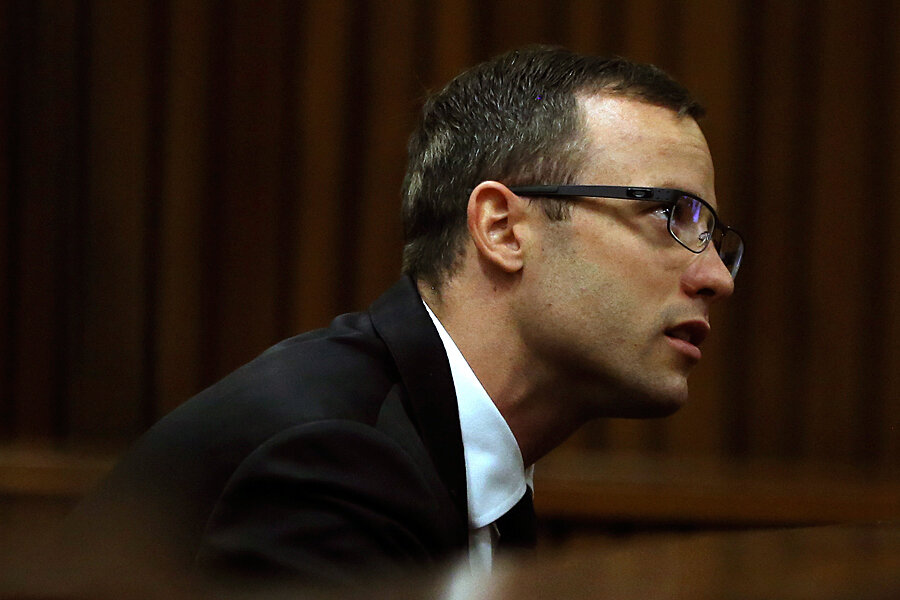As Pistorius takes the stand, a divided South Africa asks: Is he one of us?
Loading...
| Johannesburg
Is Oscar Pistorius a super-star member of a privileged elite in South Africa that never leaves its protected bubble?
Or is he an underdog who overcame adversity and a national hero to all, black and white?
Take away the Dutch-inflected surnames of most of the protagonists and witnesses, and the trial of Pistorius, on charges that he murdered his girlfriend, sometimes feels almost placeless — a splashy celebrity whodunit that could have happened anywhere in the West.
Here in South Africa, however, it has become far more personal, and the question of his guilt or innocence has cut unexpected lines across this socially and economically divided country.
The celebrity sprinter took the stand for the first time today, surprising many who had expected his testimony later in the week. Pistorius told a three-judge panel he was “simply trying to protect Reeva” when, on Valentine’s Day last year, he shot through a bathroom door four times, killing her instead of what he thought was an intruder. The prosecution argues the sprinter shot Reeva Steenkamp after a bout of angry shouting.
Pistorius tearfully apologized to Ms. Steenkamp’s family in the wood-lined Pretoria court room. Then he confided to the world that he has nightmares and can’t sleep. He said his mental outlook had been shaped by events like surviving a 2009 boating accident, and memories like his mother’s habit of sleeping with a gun under her pillow.
While Pistorius could have been cross-examined today, the chief judge, Thokozile Masipa, ended the trial early, accepting the defense argument that the defendant had not slept the night before and was exhausted.
Who is Pistorius?
Since the start of the trial last month, a global public has become intimately familiar with the blockbuster-worthy details of Pistorius’s story: his taste for guns and danger, his short-fuse temper and paranoia, the way he retched and wept with apparent horror as the condition of Steenkamp’s body was described.
But for many here, their view of the case turns on a central question: Is Pistorius really one of us?
On the one hand, of course, he is the epitome of the apartheid-era elite: a wealthy Afrikaner with a fortified suburban house and a beautiful blonde girlfriend.
But he is also a quintessentially South African underdog, the man with both his lower legs amputated who rose to become a world-class sprinter.
“When this story comes on the radio, on TV, we all sit down and listen, and we think it is so sad, because we were all looking up to this man,” says Dikgang Longwe, a disc jockey from Katlehong, a township near Johannesburg.
For Mr. Longwe and many others, the question of Pistorius’s guilt or innocence is also bound up in the behavior of his victim. Had their relationship been tumultuous? Had she done something to provoke him – perhaps quarrel with him over other love interests – the night she died?
Over the past several weeks, the prosecution has made repeated attempts to introduce those possibilities, calling to the stand a teary ex-girlfriend who said Pistorius had cheated on her with Ms. Steenkamp and introducing WhatsApp messages revealing the victim’s fear of Pistorius’s hair-trigger temper.
“I’m scared of you sometimes,” she wrote in one message.
“He killed her, and he meant to, but I think she was cheating, so she was wrong as well,” says Joseph Mkhwanazi, a groundskeeper at a gated complex in Johannesburg’s manicured northern suburbs, not unlike the one in nearby Pretoria where Pistorius lived and shot Steenkamp.
Meanwhile, Steenkamp has earned her own unlikely defender: the Women’s League of the ruling African National Congress. Every day since the trial began, a cluster of women clad in the green and black uniform of the League, most of them black and working class, have gathered at the courthouse to march in support of the slain model.
The League could “no longer accept the fate of women as victims of violent men,” said ANCWL President Angie Motshekga, who is also the minister of basic education.
Critics of the Women’s League, however, say the demonstrations are simply a ploy for media attention in the run-up to the country’s May 7 national election. And indeed, the Women’s League’s record on defending female victims is hardly pristine: In 2006, it was notably silent when President Jacob Zuma went on trial for the rape of a family friend.
The panel who will decide
In the case of Pistorius and Steenkamp, however, there are only three South Africans whose opinions truly matter: Judge Masipa (the country’s second black female judge when she was appointed in 1998) and her two assistants, known as “assessors.” Since South Africa does not have trial by jury, they alone are responsible for handing down the sentence at the end of Pistorius’s trial.
In recent years, Masipa – a former crime reporter – has given the maximum possible sentences to at least two men accused of violent crimes against women.
At the 2009 sentencing of policeman Freddy Mashamba, who killed his ex-wife during an argument, Masipa told the accused, "No one is above the law. You deserve to go to jail for life because you are not a protector. You are a killer.”






